Analyzing the Price of Mobility: Desktops vs. Laptops
by Jarred Walton on September 7, 2013 5:55 PM ESTGPU/Graphics Performance Discussion
The other area of performance we want to look at is the GPU/graphics side of the equation. Where CPU performance has really started to level off – only overclocked CPUs or hex-core/octal-core options really hold serious performance advantages over the fastest mobile CPUs, and then only in heavily threaded workloads – the same can’t be said of graphics chips. Part of the problem is power requirements, as high-end desktop GPUs can draw up to 300W under load, which is three times what the most powerful mobile GPUs are rated to draw. The form factor also comes into play, but really I think power is the far more limiting factor.
Of course, there's a big difference in terms of what we do with CPUs vs. GPUs and how we do it. Most CPU-intensive tasks don't easily scale beyond a certain level of multi-threadedness, and some tasks really don't scale at all. The easiest example is anything that requires user input: no matter how fast your CPU gets, Word isn't going to type any faster than your fingers can go – or if you use speech recognition, any faster than you can dictate. Graphics on the other hand is practically infinitely parallel, where we can break things down into smaller and smaller pieces of a screen being rendered/computed by individual GPU cores. Many tasks on the CPU don't scale beyond four or maybe eight cores, but graphics is easy to scale to thousands of cores and beyond. So GPUs can get as large/fast as we can conceivably make them and there are still ways to tap into that performance potential; that's why modern systems typically have GPUs that consume two to ten times as much power as the CPU(s).
Let’s again put together some comparisons, only this time we’re a bit more limited in what we’ve tested with modern GPUs – on our desktop tests, we only have an overclocked GTX 680 and a GTX 780 with all of our gaming results, while on mobile we have a few additional reference points. I’ve also added Bioshock Infinite and Sleeping Dogs numbers for additional GPUs from our GPU 2013 test suite, but that’s only two of the seven titles we’re testing on laptops. We’re now looking at entire systems, but the GPUs are the primary factor in gaming performance. Also note that our reference point (1080p Max Detail, usually with anti-aliasing) is far more demanding than what most gamers actually require, but in terms of a performance discussion at least we can get an idea of where mobile GPUs stand.
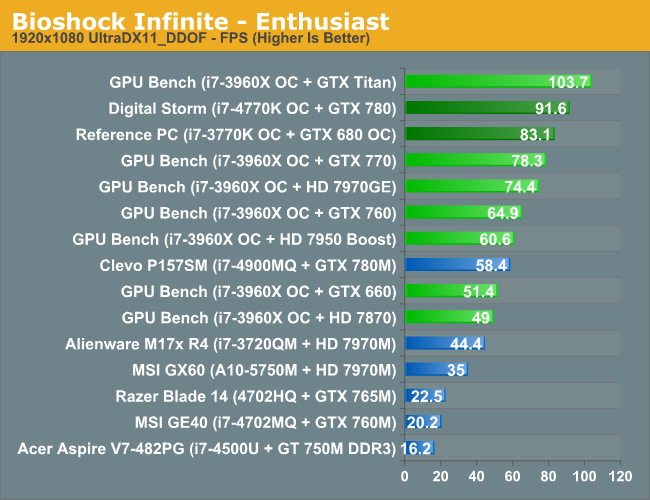
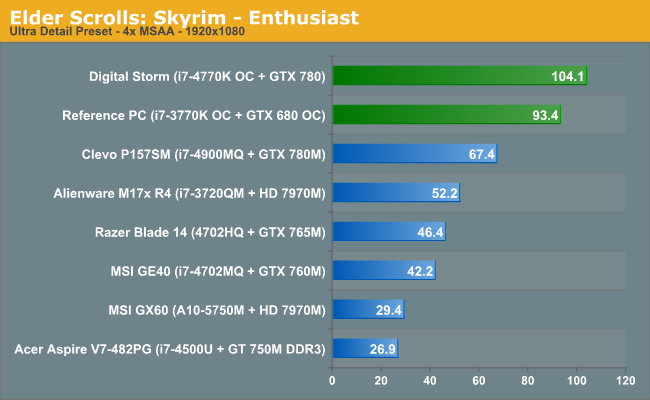
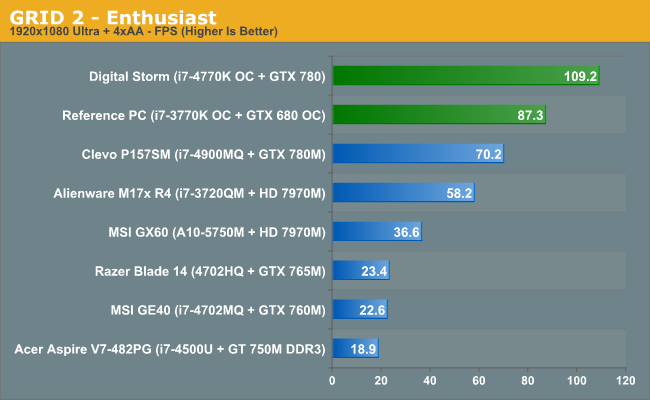


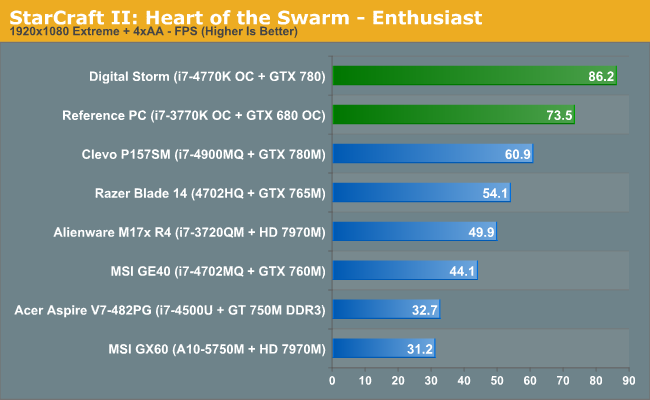
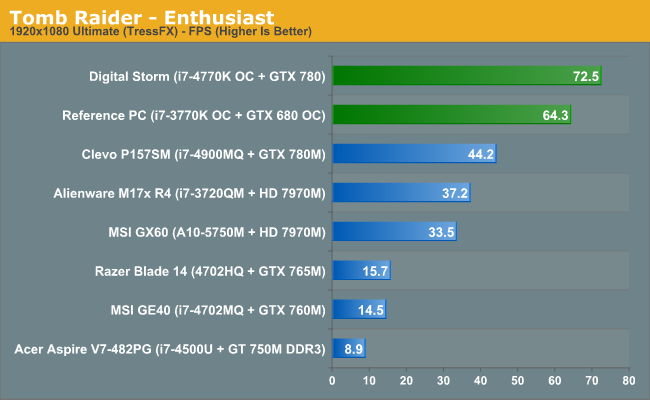
As far as replacing gaming desktop performance with a notebook is concerned, we’re nowhere near close to accomplishing this task. CPU requirements for the vast majority of users have reached a plateau during the past five or so years, but for graphics (games) we can still use pretty much all the horsepower available. The fastest mobile GPU we have right now, the GeForce GTX 780M, ends up delivering performance that falls roughly half way between the GTX 660 and GTX 760, or if we look at the Digital Storm system Dustin tested, it offers 60-70% of the performance of that desktop. Moving down to the lower performance mobile GTX parts like the GTX 765M, we haven’t tested any desktop GPUs in recent history that are anywhere near that slow – even the GTX 660 tends to be more than twice as fast as the GTX 765M and the GTX 560 Ti is still 50% faster. Drop one level further to the GT 750M (DDR3) and performance is about 60-80% of the GTX 765M! It’s not that you can’t game on a GT 750M or GTX 765M, but you’ll definitely need to drop the details down from max and turn off anti-aliasing. Finally, no matter what you do with a notebook, you’re not going to match the performance of the fastest desktop GPUs – the GTX Titan nearly doubles the performance of the GTX 780M, and even SLI GTX 780M isn’t likely to beat a Titan on a consistent basis.
Looking at pricing is also illuminating. Most notebook vendors charge around $650 (give or take) for a second GeForce 780M on the Clevo P370SM, compared to the desktop GTX 760 (which has slightly higher performance) that can be purchased for $250. Meanwhile, the desktop GTX 780M sells for the same $650 price as the GTX 780 while offering only 60-70% of the performance you get from the desktop GPU; the GTX 680 and GTX 770 have the same number of CUDA cores (1536) and go for $400, delivering superior performance at a substantially lower cost. The pattern continues as we move down the product stack; the slowest desktop Kepler, the GeForce GT 630, is a $65 card that has slightly higher clocks than the GT 750M, never mind the GT 730M and GT 740M, but the GT 730M is typically a $70 upgrade on a notebook. The GTX 765M has the same number of cores as the $130 GTX 650 Ti but with lower clocks; it reputedly sells for close to the same price to laptop OEMs as the desktop GTX 760 we mentioned as a performance equivalent of the GTX 780M.
Of course, where you can easily add a GPU to most desktops, with laptops you’re basically stuck with whatever you initially purchase. I noted in the Gaming Laptop Guide last month that the lowest price I could find for a notebook with a GTX 780M ends up around $1750 (including the OS with a 1TB HDD). For equivalent performance (more or less), we can take the desktop we listed above and add a GTX 760 GPU, with a slight PSU upgrade as well just to be safe. Here’s what we end up with:
| Mainstream Gaming Desktop PC | ||
| Component | Description | Price |
| CPU | Intel Core i5-4670 (Quad-core, 3.4-3.8GHz, 6MB L3, 22nm, 84W) | $200 |
| Motherboard | ASRock Z87 Pro3 LGA-1150 | $115 |
| GPU | GeForce GTX 760 | $250 |
| Memory | 2x4GB DDR3-1600 CL9 1.5V RAM | $65 |
| Storage | Seagate 1TB 7200RPM HDD | $70 |
| Optical Drive | SATA DVDRW (Lite-On) | $18 |
| Case | Antec Three Hundred | $60 |
| Power Supply | Rosewill Green RG530-S12 530W 80 Plus Bronze | $55 |
| Operating System | Windows 8 64-bit (OEM) | $100 |
| Total | $933 | |
Opting for a gaming notebook thus carries a hefty price premium, nearly doubling the price of a similar performance desktop. Yes, the notebook still gives you a battery, display, keyboard, touchpad, and speakers as part of the package, but if you already have those for an existing desktop they’re not really necessary. The price premium for high-end gaming notebooks has certainly come down from the 2x-3x we used to see (though you can still get to that range with SLI notebooks), but we’re nowhere near parity like we are on the CPU side of things. As an alternative, desktop GPUs are also able to hit much higher performance levels at a similar cost to a high-end gaming notebook.
Given the various options, many people have concluded that it’s far better to have a decent gaming desktop like the one above and then to spend another $500-$1000 on a good laptop for when you need to go mobile. That’s generally my recommendation as well – for all the gaming notebooks I’ve reviewed over the years, I still turn to my desktop system 95% of the time when I’m looking to play a game. On the other hand, not everyone wants to worry about having two computers and syncing data between them, and there are also space limitations to consider. Finding a spot for a 10 pound gaming notebook in a college dorm is easy enough; finding space for a gaming desktop with display, speakers, keyboard, and mouse can be a bit more difficult. And if you’re regularly on the road and want to take your games with you, you’ll need the laptop regardless.
There’s no right answer for how to do things, of course. Some people love gaming notebooks and others don’t see the point. But while you can certainly make a case for typical notebooks/laptops now being close to price parity with similar performance desktops, once you add gaming into the mix you’ll need to pay the mobility piper his due.










110 Comments
View All Comments
nerd1 - Monday, September 9, 2013 - link
My main machine is a 17" alienware with 680M, which is comparable to GTX660, and it cost me less than $2K with 16GB ram and 500GB SSD / 1TB HDD. It is not terribly heavy (I carry it with backpack every day), fast enough for my work, and runs most game at 1080p easily.Similarly powerful desktop will be around $1400 (after adding display, keyboard and SSD), and I will still need a quality laptop with SSD, which won't come below $1000. So I think powerful laptop systems totally make sense for *some* people who are fine with 1080p gaming.
Notmyusualid - Monday, September 9, 2013 - link
Jarred, amazing if you can get that performance for ~$1k.But most of us outside the USA pay through the nose for our electronics.
My machine cost, (sourced in the UK) 3k GBP, without fancy SSDs, TB disk, nor memory. Factor in 800 GBP for those and your 3800 GBP machine is $5966.38 - including case but *without taxes*. And VAT (sales tax) here is 17.5%.
Oh how I wish I could have spent that on a Desktop... but as noted, that is not an option for me.
Love the article, and the site - keep up the good work, and try not to cry reading those prices! :)
JarredWalton - Tuesday, September 10, 2013 - link
Obviously prices have come down since your original purchase on some parts, but yeah -- desktop GTX 760 with a bit of overclocking is going to be pretty close to 780M SLI performance. Some cases it might be a bit slower, but you could always upgrade to a slightly faster GPU for not much more money. Glad I don't have to pay your prices!JlHADJOE - Tuesday, September 17, 2013 - link
Well I never thought about bringing a desktop along. I figured for most people the setup would be a desktop at home, and a laptop on the road. I suppose you're the exception here.My desktop is a 4770k and GTX780. I'm not sure if it's faster than your M18x, but I imagine they'd be about even. I have a Macbook Air for when I'm mobile.
LDW - Sunday, September 8, 2013 - link
Thank you for an interesting analysis. I would like to suggest another angle for a future analysis....Constrain the laptops and desktops to use just the on-chip graphics processing made available from Intel and AMD, and pick several games that place lighter loads on the hardware to use to study their performance. These games may be older or may be current games with constrained settings.
The question to be asked by the analysis is "How is the on-chip graphics doing in in the market? How does it compete with the discrete graphics (mobile and static)? Might there come a time in the future where the graphics performance of the on-chip graphics processors be 'good enough'?"
I think the answer to the last is yes, but haven't a clue when that will occur. Thanks again for an interesting analysis.
LDW
jtd871 - Sunday, September 8, 2013 - link
I was a bit disappointed to see that mobile IVB was not included as a comparison point, as many mobile owners will have purchased in the past several years.As has been inidicated by many others, the performance just has to be good enough. My lappie is a iBuyPower CZ-17 (17" 108p, IVB i7, GTX675m) with aftermarket RAM and SSD upgrades. I probably have $1800 in it. The cost is worth the smaller footprint. My kids are using my previous laptop (Lenovo ThinkPad T61 w/Core2Duo & NVS discrete gfx), which cost the same amount 5 years previously.
As a comparison, the performance gained for the same money over 5 years is tremendous. My 'best value' paper build list for a $1500 desktop (including OS) would probably smoke my current laptop, but the laptop is still very nice for 1080p gaming and 1) I didn't have to put it (all) together myself 2) it is portable.
The whole notion of battery life on a gaming laptop is kind of silly. It's basically a glorified UPS (which I appreciate), as I have pretty much never heard of anyone gaming without being on the mains.
JarredWalton - Sunday, September 8, 2013 - link
Ivy Bridge wasn't included because, outside of the iGPU and battery life, it's not really all that different from Haswell. In fact, outside of the iGPU and battery life, even Sandy Bridge offers competitive performance to Ivy Bridge.As for battery life on a gaming notebook being silly, I don't think most people really expect to be able to play a modern AAA title like Battlefield, Call of Duty, etc. and get good battery life, but when you're not gaming there's really no need for battery life to suck.
By my calculations, a 17.3" gaming notebook at idle should be able to draw around 10-13W max, mostly depending on the LCD brightness. Sadly, most are still drawing 20-25W at idle. There's no reason for this other than the manufacturers being too lazy to properly optimize the firmware for power savings.
Termie - Sunday, September 8, 2013 - link
Great article, Jarred! Wow, it's amazing to see what those Haswell mobile quad-cores can do!By the way, you refer to the i7-4500U in the text, but your chart has the i7-4200U. I think the text is correct, and the chart isn't.
nunomoreira10 - Sunday, September 8, 2013 - link
Either cpu perfomance has evolved so much on laptops or evolved so litle on desktops.intel need some competition and fast
the bright side is i wont be losing much if i get a mainstream quadcore laptop
JarredWalton - Sunday, September 8, 2013 - link
The thing is, for the most part people don't need faster CPUs. If we had CPUs that were 10X as fast, what would we do that we're not already doing? Intel has plenty of competition: ARM is the big one, but Intel is almost competing with their own past success. Until there's software that needs more CPU performance, focusing on other priorities like power and graphics makes more sense.And for the record, I don't think we need lots of new "innovations" in software that require faster CPUs. Look at Android and iOS; those require basically one fourth the performance of Windows to be plenty fast (outside of some web page rendering), and they deliver tons better battery life. More than anything, I think we're fast approaching the point where monolithic OSes, CPUs, etc. start to become irrelevant.
A few more years and I could do most of what I need to do with an iPad/Android tablet with a good keyboard attachment. I'll still prefer laptops though, because larger displays and keyboards are more comfortable for me to use -- at least, I will until we reach the point where we can actually start connecting our brains directly into our computers. Hahaha....